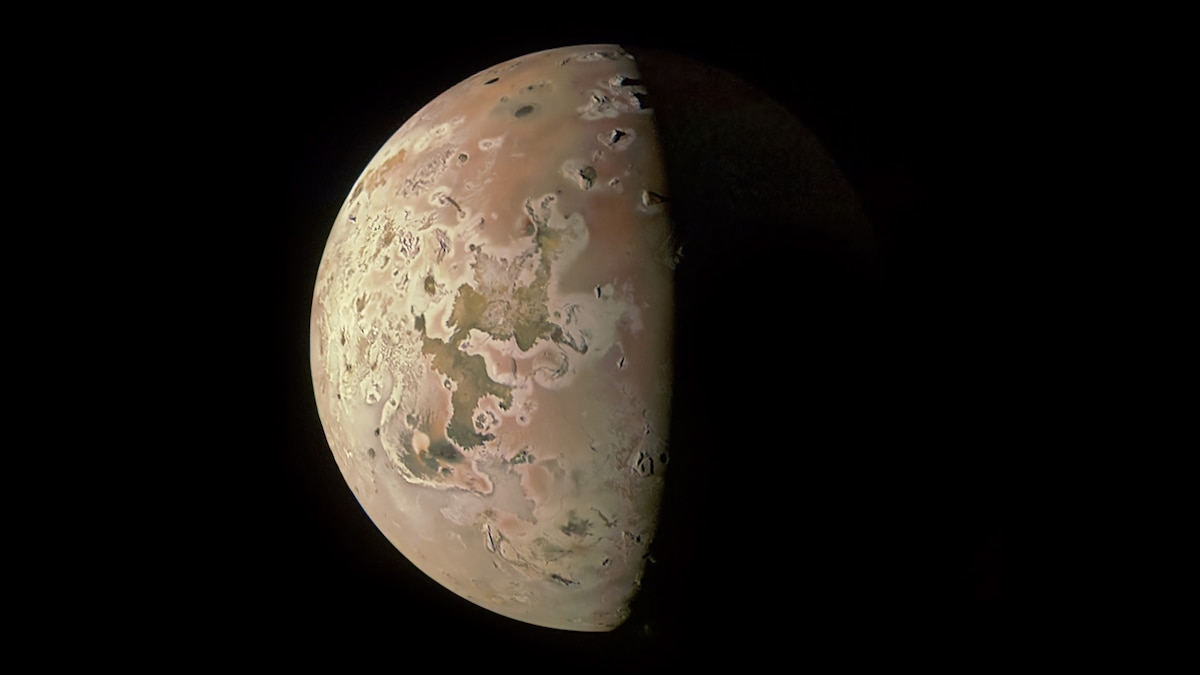Earth’s silvery moon is impressive in many ways, but it doesn’t hold a candle to those of the solar system’s gas giant planets. These moons are worlds unto themselves. Some, like Europa or Enceladus, have spectacular and perhaps even habitable liquid water oceans. And then there’s Jupiter’s moon, Io.
Io is the most volcanic object known to science. A rust-hued orb, its rocky seas of lava are larger than cities and its eruption plumes arc across the sky like infernal umbrellas. Yet until now, scientists have had little idea of Io’s history, including for how long it has been so eruptive. Io’s volcanism means that the moon resurfaces itself every million years.
All worlds are dynamic, and those with beating geologic hearts change—sometimes in extreme ways. Earth’s past self, for example, was very different from its present form. What about Io? Was it always a fiery hellscape?
To find out, astronomers studied its atmospheric chemistry to work out how long it might have taken for countless eruptions to shift its composition from an ancient starting point. Yet as they reported today in the journal Science, Io looks to have more-or-less been continuously erupting for billions of years—perhaps even 4.5 billion years, or for as long as the solar system itself has existed. In other words, Io has been volcanically hyperactive for as long as the sun itself has been shining.

These composite views depicting volcanic activity on Io were generated using both visible light and infrared data collected by NASA’s Juno spacecraft during flybys of the Jovian moon on Dec. 14, 2022 (left) and March 1, 2023. In both views, the view of the moon (in mottled grays and browns) is provided by the JunoCam imager. The overlays of reds, yellows and bright whites is data from spacecraft’s JIRAM (Jovian Infrared Auroral Mapper) instrument. Annotated views like these can help the Juno science team better understand location and variations in the active volcanoes on the moon’s surface.
Photograph by NASA/JPL-Caltech/SwRI/ASI/INAF/JIRAM
“We are seeing Io just as it’s been all along!” says Jani Radebaugh, a planetary geologist at Brigham Young University and who wasn’t involved with the new work. That makes Io a time machine of sorts, whose unyielding heat engine—one powered by gravitational tides—can tell us about worlds both near and far.
“That process is going on throughout the solar system, as well as in exoplanets,” Katherine de Kleer, a planetary astronomer at Caltech and the study’s lead author. “We study Io to better understand this universal process.”
FREE BONUS ISSUE
A volcanic paradise
The solar system may not look that changeable from a human perspective. But it most certainly is on astronomic timescales. For example, in recent years, scientists have found that Saturn’s iconic rings were not permanent fixtures, but recent decorations: they formed a few hundred million years ago, and they will fade away in a similar amount of time.
Io, then, may not have always been the volcanic maestro it is today. But to find out, we must understand how its volcanism works—and why it’s so dramatic.
In 1979, two major science moments laid the ground work: NASA’s Voyager 1 spacecraft flew through the Jovian system and photographed ginormous plumes of volcanic matter rising above Io’s surface, and an independent team of scientists calculated that Io may possess a potent, but unusual, source of heat.
That mathematical prediction came from the strange voyages of Europa and Ganymede, a pair of moons close to Io. Every time Ganymede makes a complete orbit of Jupiter, Europa makes two, and Io makes four. This rhythm, known as a resonance, alters Io’s own orbit, shaping it into something more elliptical than circular.
When Io is closer to Jupiter on its wonky orbit, it experiences a stronger gravitational pull; when it’s more distant, the gravitational pull of Jupiter is a little weaker. That causes tides on Io not dissimilar from the way Earth’s moon makes tides in our own world’s seas and oceans. But in this case, the tides are so strong that Io’s surface trampolines up and down 330 feet—comparable to a small skyscraper.
All that movement creates a lot of friction, which generates an astonishing amount of heat. Within Io, that heat melts a considerable amount of rock, perhaps creating an ocean of magma. And that powers some truly fierce eruptions at its surface, often taking the form of serpent-like rivers of lava longer than most of Earth’s watery versions, towering columns of sulfur-rich lava confetti, and cauldrons of liquid rock that act like portals into Io’s underworld.
You May Also Like
“It’s awesome,” says de Kleer. “It has these volcanoes that give us a window into what’s happening inside the moon, which is something we don’t usually have.”
The extreme nature of its volcanism doesn’t stop with its eruptions. As well as sulfur-containing compounds, it coughs out gases made of sodium and potassium chloride. On Earth, we use these to season our food. “It’s like table salt gas that’s coming out of the volcanoes,” says de Kleer.
Much of its erupted material can also be jettisoned through Io’s thin atmospheric bubble and into space. There, it mingles with sunlight, gets electrically excited, before falling into Jupiter’s magnetized skies and exploding as powerful aurorae—the gas giant’s version of Earth’s northern and southern lights.
Mad moon
Io’s source of heat—a mechanism known as tidal heating—is ultimately responsible for all this planetary sorcery. Scientists wanted to know if that tidal heating always existed within the moon. But as it’s so volcanically active, its lava flows have quickly and repeatedly covered its surface, burying any evidence of ancient geologic processes.
“It’s not possible to look at Io’s surface and say something about what happened more than a million years ago,” says de Kleer. That’s why she and her team took a different approach and looked to its skies instead.
Io loses as much as three tons of material every single second to space through its volcanic outgassing and atmospheric erosion. “One could argue that Io’s losing its mass like a comet,” says Apurva Oza, a planetary astrophysicist at NASA’s Jet Propulsion Laboratory who wasn’t involved with the new work.
Over time, that would mean that Io’s modern-day eruptions will be relatively enriched in heavier versions (isotopes) of various chemical elements than lighter ones, because lighter isotopes in the upper atmosphere can more easily escape into space. If the team could measure the present-day ratios of the atmosphere’s heavy isotopes to lighter isotopes, they could calculate how long it would have taken for Io to get to that state from an original reservoir of subterranean, but eruptible, compounds within Io.
Using the Atacama Large Millimeter/submillimeter Array (ALMA) in Chile to observe gases in Io’s atmosphere—most notably, sulfur—de Kleer’s team did just that. They also estimated the moon’s “original” reservoir of heavier and lighter isotopes by using (among other things) ancient meteorites, which preserve a record of the average chemistry of the primeval era of the solar system.
They found that the high proportion of heavier sulfur isotopes in today’s Ionian atmosphere suggests that Io has lost 94 to 99 percent of its original sulfur reservoir. And the only way that makes sense, and fits with preexisting models of the evolution of Jupiter and its inner moons, is that Io has been erupting for perhaps as long as 4.5 billion years.
Orbital dance
“The orbital dynamics of planetary satellites can get very chaotic,” says James Tuttle Keane, a planetary scientist at NASA’s Jet Propulsion Laboratory who was not involved with the new work. Moons can drift in and out of stable orbits, sometimes colliding or potentially being ejected from the solar system entirely.
But it seems that Io, Ganymede, and Europa have been dancing about in a similar way for billions of years, and “the Io we see today is somewhat representative of Io over its long history,” says Keane.
That’s extraordinary in itself—but it also has implications for Io’s neighbor, Europa. This icy orb not only has a liquid water ocean beneath its frozen shell, but it is thought to be kept warm and liquid by tidal heating too. That means that if Io has been volcanically active for billions of years, then Europa’s ocean may be similarly primeval.
“Maybe this has some implications for the long-term history of Europa’s habitability,” says de Kleer. We don’t yet know if this ocean contains life. But if it does, it owes its existence to the same eternal force that makes Io blaze with volcanic fire.





